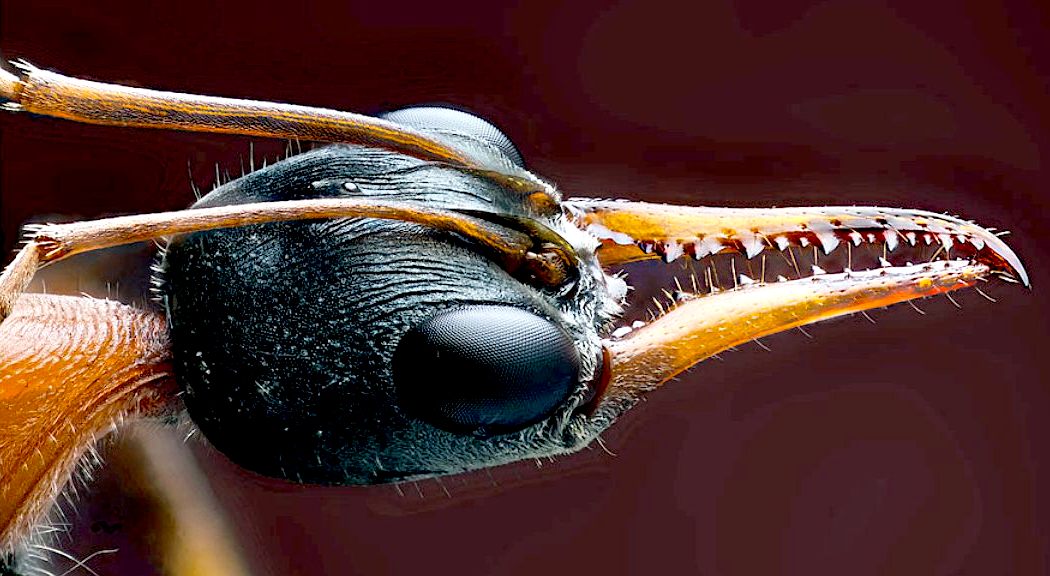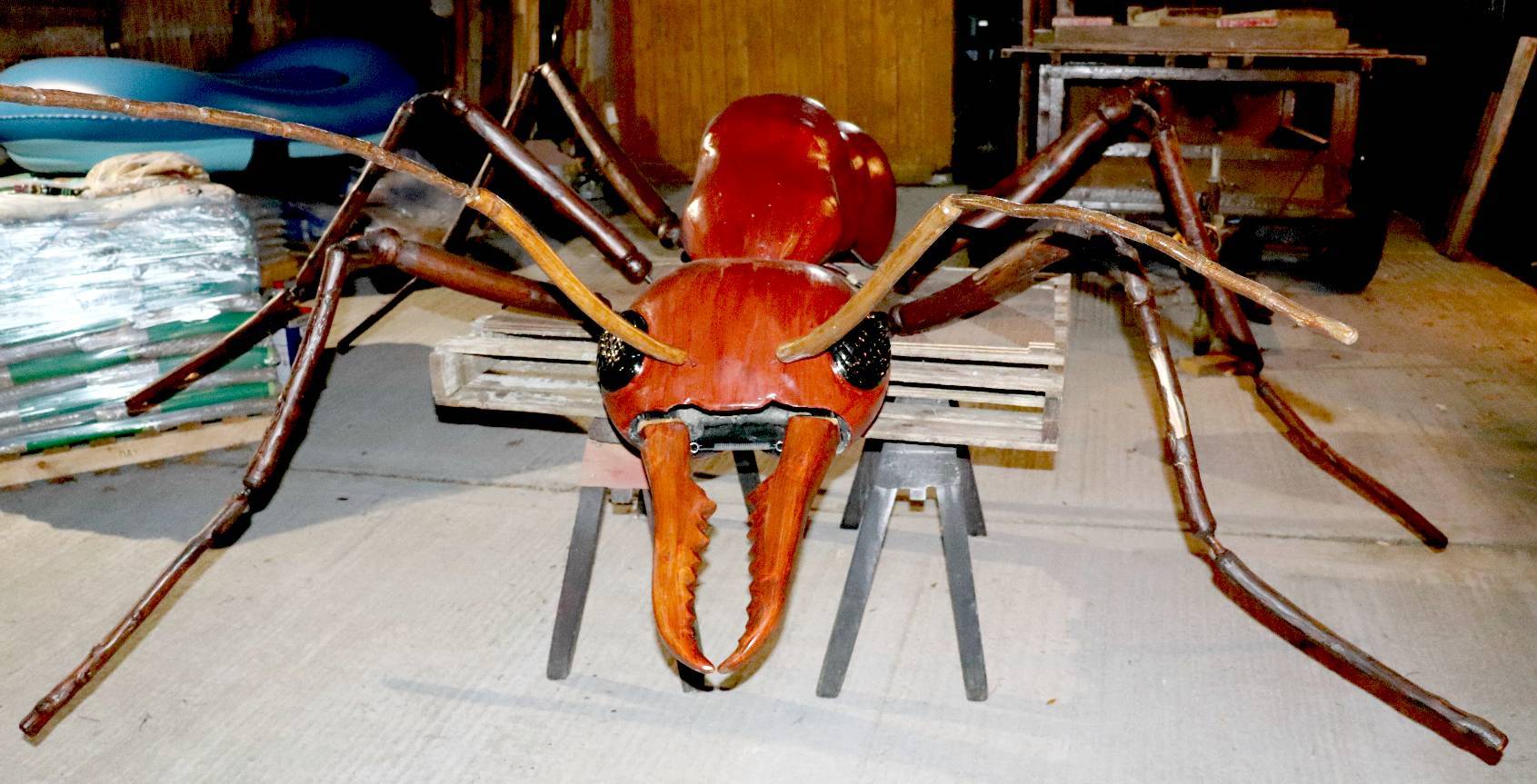|

Most
animals and machines do not have a adaptable cloaking skin, thus remain
visible against incongruous backgrounds
CHRISTMAS
GIANT ROBOT ANT PROJECT
Everybody
knows about the humble chameleon, a reptile that can change the colour of
its skin to blend in with the background, to become virtually undetectable
to the insects it is hunting. This ability approaches the ultimate in
natural biological camouflage.
Humans
use paint and printed (dyed) clothing to achieve something similar, and
that works to some degree to fool the eye, to make soldiers and tanks or
ships less obvious, but not against thermal imaging systems. The same
applies to stealth ships and planes, that avoid radar.
LIGHT MANIPULATION & DISTORTION
Another
idea for invisibility is to bend light around the Target or project onto the target a pattern that renders it functionally invisible. A vehicle (in this case a robot) uses cameras & projects the image it sees from behind onto the front facing bodywork. It projects
from the opposite side so the front for projects what is behind it effectively rendering it invisible.
Though, such a system is costly and fragile.
And even so, such a system could not get rid of the Heat being poured out of a live human,
or a vehicle with an engine and so the thermal targeting and imaging systems would still see it.
But an electrically propelled robot that is stationary, produces no heat, other than that of the computers inside. Which in the case of a smartphone and other micro processors, is not
so much that it cannot be dissipated from other regions - again -
rendering the robot invisible.
Oddly enough the US military is not particularly looking for an invisibility cloak. There are rudimentary systems now that try to redirect light around objects.
Most interesting is DARPA’s desire for “signature management” to reduce the enemy’s ability to detect the tank through visible light, infrared radiation, sound, or electromagnetic sensors such as radar. A tough challenge.
Imagine though if people were invisible on the battlefield. The problem becomes that all battle systems in humans are hot and they will emit thermal radiation that would be visible to weapon systems even if the passive reflected light you gave off was cloaked. The Army has made this clear that they don't want to make tanks invisible to eyesight they want to make them invisible to thermal imaging systems
As a result, some of the thermal invisibility cloaks do the opposite of what you would think. They actually produce heat and the object (tank) is covered in plates, that the tank can make a thermal pattern to trick a helicopter pilot say to see a car on the battlefield not a tank.
CHAMELEON COLOUR CHANGING
Some chameleon species are able to change their skin coloration. Different chameleon species are able to vary their coloration and pattern through combinations of pink, blue, red, orange, green, black, brown, light blue, yellow, turquoise, and purple. Chameleon skin has a superficial layer which contains pigments, and under the layer are cells with very small (nanoscale) guanine crystals. Chameleons change color by "actively tuning the photonic response of a lattice of small guanine nanocrystals in the s-iridophores". This tuning, by an unknown molecular mechanism, changes the wavelength of light reflected off the crystals which changes the color of the skin. The color change was duplicated ex vivo by modifying the osmolarity of pieces of white skin.
Color change in chameleons has functions in camouflage, but most commonly in social signaling and in reactions to temperature and other conditions. The relative importance of these functions varies with the circumstances, as well as the species. Color change signals a chameleon's physiological condition and intentions to other chameleons. Because chameleons are ectothermic, another reason why they change color is to regulate their body temperatures, either to a darker color to absorb light and heat to raise their temperature, or to a lighter color to reflect light and heat, thereby either stabilizing or lowering their body temperature. Chameleons tend to show brighter colors when displaying aggression to other chameleons, and darker colors when they submit or "give up". Some species, particularly those of Madagascar and some African genera in rainforest habitats, have blue fluorescence in their skull tubercles, deriving from bones and possibly serving a signaling role.
Some species, such as Smith's dwarf chameleon, adjust their colors for camouflage by the vision of the specific predator species (bird or snake) by which they are being threatened.
Chameleons have two superimposed layers within their skin that control their color and thermoregulation. The top layer contains a lattice of guanine nanocrystals, and by exciting this lattice the spacing between the nanocrystals can be manipulated, which in turn affects which wavelengths of light are reflected and which are absorbed. Exciting the lattice increases the distance between the nanocrystals, and the skin reflects longer wavelengths of light. Thus, in a relaxed state the crystals reflect blue and green, but in an excited state the longer wavelengths such as yellow, orange, green, and red are reflected.
The skin of a chameleon also contains some yellow pigments, which combined with the blue reflected by a relaxed crystal lattice results in the characteristic green color which is common of many chameleons in their relaxed state. Chameleon color palettes have evolved through evolution and the environment. Chameleons living in the forest have a more defined and colorful palette compared to those living in the desert or savanna, which have more of a basic, brown, and charred palette.
One
can imagine, that in evolution, if there was some survival advantage for
avoiding thermal signatures, animals like the chameleon would eventually
evolve to solve the problem, or not survive. The key to all adaptations is
survival at all costs. As in, on a battlefield, where unfortunately, the
cost benefit ratio reduces development. Not so in nature.
ADAPTIV
ADAPTIV was developed and patented in Sweden after FMV and the Swedish Defence Materiel Administration commissioned BAE Systems in Örnsköldsvik to produce full-scale technology for land vehicles to avoid detection from thermal sensor systems.
After three years of challenging research, a project team of seven people, with expertise in the fields of problem solving, software, sensors, electronics and design, developed this unique solution.
The high tech camouflage system uses modules, which look like cells in a honeycomb to cover the flanks of an armoured vehicle. The modules are made of elements that can be cooled or heated up very quickly as well as controlled individually, allowing different patterns to be created.
The vehicle essentially works like a chameleon, able to mimic its surroundings, or copy other objects such as trucks and cars that can be projected onto the panels from a detailed image bank. The vehicle is also able to signal peaceful intend through flashing text messages across its flank or by creating patterns that can easily be recognized by friendly forces.

Movie idea, lurking beneath the Antarctic
ice is a discovery that scientists will die for. This original story is
the subject of book and script development, as part of the John Storm climate
awareness series.

A
Sectasaur™ (thawed) - now on permanent display at Herstmonceux
Museum, in Sussex, England.
ANTICS
- ARDUINO
- ARMOUR
- ARTWORK
- BIPEDAL
HUMANOIDS - BLACK
BOX -
CHAT GPT
- ELECTRONICS - ENERGY - FRAME
- FORMICARIUM
HEAD -
INVISIBILITY
- JAWS -
KITS -
LEGS - MECHANICS
- MOTORS -
MOVIE
- RASPBERRY
Pi - R/C DRONE - SENTRY
- SOFTWARE
SIM
CARDS - SMARTPOHNES
- SOUND PROOFING
- SPACE
ROVERS - SPEED
- STEM
- SUSPENSION
- TAIL
- WEAPONS
- WARGAMING
|

